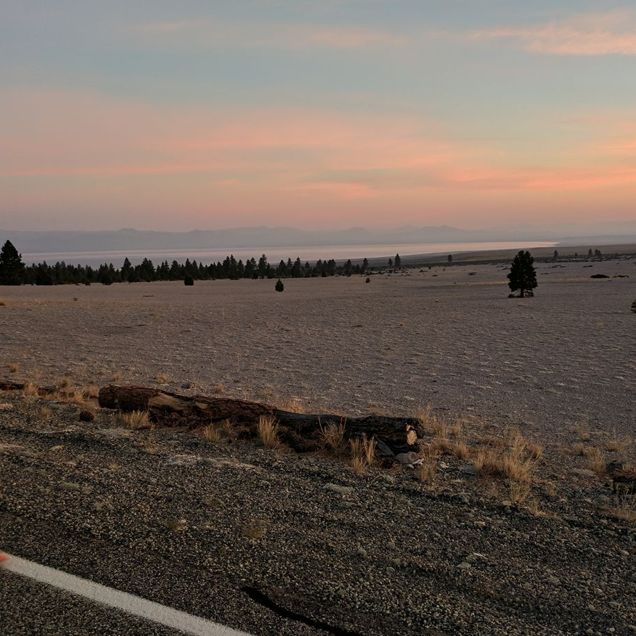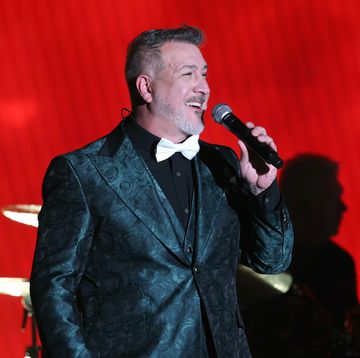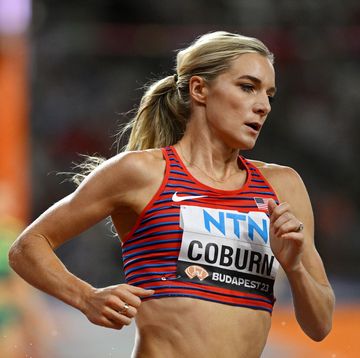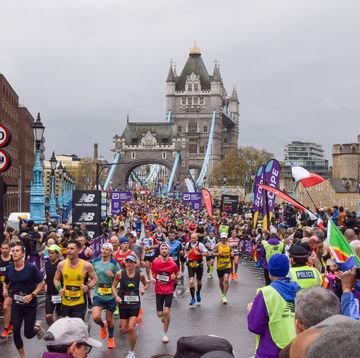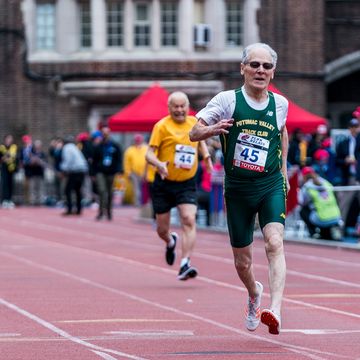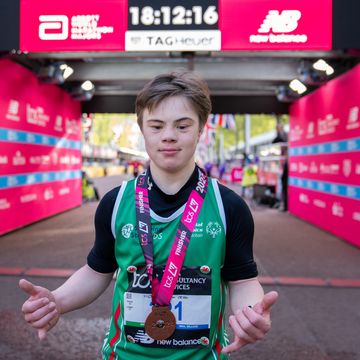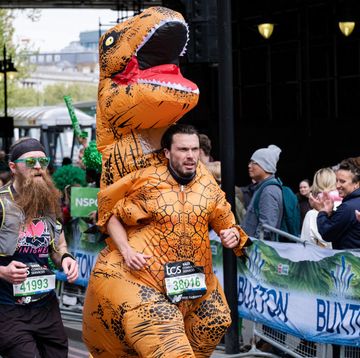It was 1:24 a.m. on November 5 when Sandra Villines climbed the steps of City Hall in New York, exactly 54 days, 16 hours, and 24 minutes after the 45-year-old from San Jose, California, departed San Francisco.
Villines’s 3,126-mile trek across the country had just become a women’s trans-American record. Thanks to an average clip of more than 56 miles per day, Villines surpassed the previous mark—South African Mavis Hutchinson’s 1979 performance of 69 days, 2 hours, and 40 minutes, run on a slightly shorter route beginning in Los Angeles—by more than 15 days.
And while her phone blew up with congratulatory messages from her supporters, Villines wasn’t the only woman making running history that day in Manhattan. Later that morning, Shalane Flanagan became the first American woman in 40 years to win the New York City Marathon, capturing the attention of fans around the world.
“The record wasn't the biggest thing,” Villines told Runner’s World several days after completing her run. “I just wanted to see America on foot, to enjoy the journey, and to inspire others by accomplishing things that don’t seem accomplishable.”
Such is life for the ultrarunning community—always dedicated, but intimate and usually out of the mainstream spotlight. Villines isn’t new to it, either. The mother of one (who will soon be a grandmother, too) didn’t start running until she was 38, inspired by reading about, then meeting Dean Karnazes, author of Ultramarathon Man: Confessions of an All-Night Runner.
By 2016 Villines was lining up for Badwater, the 135-mile race through Death Valley, featuring more than 14,000 feet of elevation gain and temperatures rising to 130 degrees Fahrenheit. The very next year she won the race.
Those big feats take the support of friends, and Villines’s support system rose to the occasion not only then, but also when she decided to cover the United States on foot.
Jay J. Lee, a certified public accountant from Fremont, California, drove the lead hatchback and served as chief problem-solver, navigating the entirety of the route on local, pedestrian-accessible roadways across 12 states.
“I fed her, I kept her hydrated, I gave her supplements,” Lee said.
Perhaps most important, Lee also documented each leg of the journey, providing all the evidence needed to prove Villines had run every step of the way. Some past record attempts have been questioned by fact checkers or nullified on allegations of runners taking shortcuts or rides, or fabricating data. Lee combatted any doubt through a binder full of corroborating documents and multiple GPS devices' worth of location, time, and even cadence data.
RELATED: Ultrarunner's Record Attempt Called into Question
Meanwhile, Cinder Wolff, the other half of the crew, took care of piloting the “Mothership” (the RV where Villines slept) and coordinating Villines’s rest and nutritional needs. A massage therapist from Gaston, Oregon, she also helped keep Pete Kostelnick healthy during the Nebraskan’s 2016 transcontinental run, which set the all-time men’s record of 42 days, 6 hours, and 30 minutes.
Wolff was also in charge of Villines’s nutrition, which was critical to keeping her moving forward. The go-to choice of fuel each day was a smoothie that contained protein powder, fruit, vegetables, and coconut water. Villines consumed three 24-ounce smoothies per day. Making up the daily calorie deficit took a bit more creativity, though.
“Her favorite meals were tater-tot casseroles, goulash, a lot of fried bread, and a lot of fried rice,” Wolff said. “For breakfast virtually every morning, she had cream of wheat, scrambled eggs with cheese, and a piece of toast. And the higher the elevation, higher the rise, the more calories.”
All told, Villines was taking in an average of roughly 6,000 calories per day. Her ascent up the Rocky Mountains called for 10,000-plus calorie days.
But Lee maintains the mental part of the challenge may have been tougher than the physical. Although the experience of seeing the country from a far different perspective was rewarding, the elements, terrain, and wildlife were often challenging. Breaking those obstacles down into more manageable pieces was important.
“If you were to tell somebody to run 57 or so miles, every single day, for 55 or more days, no one would be able to do that,” Lee said. “So we just took it one day at a time, and once we started, we just focused on getting to the RV for lunch, then, after we started again, we just focused on getting to the RV again for dinner.”
Never mind that the RV was parked 20 to 35 miles down the road during each of these instances. Even on days when extreme fatigue and soreness rendered running impossible, Sandra kept up the forward momentum.
“One day, going through Utah, all Sandra could do was walk, so she walked 55 miles,” Lee said. “That’s all she could do, but she just kept moving.”
The final two-day effort was the longest single leg of the journey. Positioned then in northeast Pennsylvania, the group saw that New York was “just” 135 miles away.
They’d started out on September 11—a day marred by solemnity and tragic memories. Now they were in range to finish on Marathon Sunday, a decidedly happier occasion. The choice was practically made for Villines: get to New York in one shot.
After crossing into the city via the George Washington Bridge in the middle of the night, the final leg of the run swung downtown along the Hudson River to City Hall Park.
Soon after they arrived, a city worker with a key to the gate emerged to let the party reach the City Hall steps.
After some celebratory photo taking, the historic journey was over.
Related video:
True to understated form, the team then retired to an RV park across the Hudson in Jersey City, New Jersey, for some well-earned rest. Villines flew back to California shortly thereafter, and received a hero’s welcome at Fresno Yosemite International Airport.
Her mom, Rachel Villines, was waiting for her with a bouquet of roses, saying, “we'll take her home and fatten her up.”
And for her part, Sandra Villines kept the hype to a minimum, already anticipating her return to the daily grind, where she’s a district manager of a dozen Walgreen stores.
“I'll go back to work Thursday,” she said. “It may take a little adjustment.”
